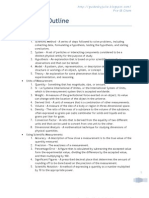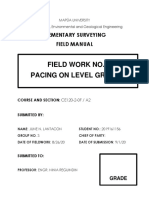Chapter 1 Introduction
Uploaded by
Mark Joseph FerrerChapter 1 Introduction
Uploaded by
Mark Joseph FerrerCHAPTER 1. INTRODUCTION 5. SPEED the ratio of distance travelled and time of travel.
v = d/t
TECHNIQUES IN PROBLEM SOLVING 6. PRESSURE a push or force against each unit area of an object’s
surface.
1. Read carefully
P = F/A P = hdg
2. Make illustration
Measurement
3. Write down the given facts or data
• A process of comparing a known quantity like measuring
4. Know what is to be found device to an unknown quantity, things or objects to be
measured.
5. Write the equation that relates the given data to the
unknown • The process of determining how many times a certain
quantity is contained in a standard measuring device.
6. Note if similar quantities are in the same units
• Can be classified as qualitative or quantitative
7. Solve the unknowns by applying the appropriate
equations. Systems of units
8. Review your work. • Units of measurement were standardized about 200 years
ago.
Physical quantities and Si units
• Two systems that carry different standardized units: the
Physical quantities
British or English system and the metric system.
• Are the numerical equivalent or quantitative description
• The English system was first adopted in England and later
of matter or object.
became widely used in the United States. It is also known
• Can be classified as fundamental quantities or derived as FPS system.
quantities.
• The metric system, which originated in France in 1791, has
• Can be also classified as scalars or vectors. the units of m, cm, kg and s.
Fundamental quantities • The modern metric system has been officially named and
is known worldwide as the International System of Units
• Are often the basis of measurements. (SI units).
• Measured directly using measuring devices and tools. • It was fully adopted in the Philippines in January 1, 1983.
1. LENGTH (meter) the distance between two distinct • Batas Pambansa No. 8
points.
Scientific Notation
2. MASS (kilogram) the measure of the amount of
material in an object. • A number is expressed as a product of two numbers.
3. TIME (second) the regular interval between two • COEFFICIENT
successive points.
• EXPONENT
4. ELECTRIC CURRENT (ampere) the measure of the flow
Rules
of electrons or charges.
• ADDITION AND SUBTRACTION all values should have
5. LUMINOUS INTENSITY (candela) the amount of
the same exponent.
illumination received by an object.
• MULTIPLICATION multiply the coefficient and add the
6. AMOUNT OF SUBSTANCE/ NUMBER OF MOLES (mole)
exponents.
the amount of substance expressed in moles.
• DIVISION divide the coefficient and subtract the
7. TEMPERATURE (kelvin) the measure of the hotness of
exponent of the denominator from the exponent of the
an object.
numerator.
Derived quantities
• Expressed as mathematical combinations of several
fundamental quantities
• Quantities based from fundamental quantities
1. AREA the total space within a two-dimensional figure.
A=LxW SIGNIFICANT DIGITS
2. VOLUME the amount of space occupied by matter. V = L x W x 1.All nonzero digits are significant.
H
Ex. 123 cm 45678 L
3. DENSITY the mass per unit volume. d = m/v
2. Zeros between nonzero digits are significant.
4. WEIGHT the amount of pull of gravity on an object. W = mg
Ex. 5007 g 1000237 mL • TEMPERATURE
3. Leading zeros or zeros preceding nonzero digits are not significant. °C = (°F – 32) / 1.8
They simply indicate the position of the decimal point.
° F = 1.8 (°C) + 32
Ex. 0.019 mL 0.000015 g
K = °C + 273.15
4. Trailing zeros or zeros at the end of a number and to the right of
decimal points are significant. All zero preceeding a decimal point
are significant
Systematic error and random error
Ex. 80.40 mL 97.500 g
• SYSTEMATIC ERRORS are consistent inaccuracies in the
Significant digits in calculations result of an experiment that may be incurred due to
equipment itself or flaw in the experiment procedure.
• MULTIPLICATION & DIVISION the number of significant (Built in errors)
digits in the product or quotient should be the same as the
given with the least number of significant digits • RANDOM ERRORS are errors in the measurement or
reading due to the precision on the instrument.
2
Ex. (1.234 cm) (1.5 cm) = 1.851 cm = 1.9 cm
2 (Estimation)
¿ ¿
Accuracy & Precision
5.86 in / 1.98 in = 2.96 in
• ACCURACY the closeness of the experimental values to
• ADDITION & SUBTRACTION the number of significant the expected or true value.
digits to the right of decimal point in the result should be
the same as the measurement with the smallest number • PRECISION the closeness of the experiment values with
of significant digits to the right of decimal point. one another.
• Example. 73.216 g + 12.34 g + 13.2 g = 98.756 g = 98.8 g Vector addition
74.626 g – 28.3 g = 46.326 g = 46.3 g Vector addition by graphical method
Conversion of units • RESULTANT the sum of two or more vectors. This vector
may be found by using the graphical method and/or the
Common metric units component method.
• LENGTH • GRAPHICAL METHOD it involves drawing vectors to
scale. The directions are determined by using a protractor.
1m 100 cm
Steps in the graphical method
1m 1 000 mm
• 1. choose an appropriate scale and coordinate system for
the given vectors.
1m 1 000 000 µm
• 2. draw the first vector starting from the origin of the
1m 1 000 000 000 nm coordinate system. Then draw the second vector starting
from the head of the first vector. Proceed to draw the
remaining vectors from the head of the last vector drawn.
1m 10 000 000 000 Angstrom (A)
All vectors must be connected head-to-tail.
1 000 m 1 km • 3. draw an arrow connecting the tail of the first vector to
the head of the last arrow drawn. This arrow represents
the resultant of the given vectors.
• MASS Vector addition using the Pythagorean Theorem
1 kg 1 000 g Vector addition by using component method.
1g 1 000 mg Prepared by:
1 000 kg 1 metric ton JAYMARK LADIA SANCHEZ
PHYSICS TEACHER
• VOLUME
1L 1 000 mL
1L 1 000 cc
You might also like
- Edexcel IAL As Physics Revision Guide Unit 1ANo ratings yetEdexcel IAL As Physics Revision Guide Unit 1A54 pages
- Grade 11 Chemistry Notes Vol I (2022-2023)No ratings yetGrade 11 Chemistry Notes Vol I (2022-2023)82 pages
- Unit I: Introduction To Chemistry: LEARNING OUTCOMES: After Successful Completion of This Unit, You Should Be Able ToNo ratings yetUnit I: Introduction To Chemistry: LEARNING OUTCOMES: After Successful Completion of This Unit, You Should Be Able To23 pages
- Physics For The IB Diploma Coursebook - Pritha Rathi - 2022 - Choithram International - Anna's ArchiveNo ratings yetPhysics For The IB Diploma Coursebook - Pritha Rathi - 2022 - Choithram International - Anna's Archive246 pages
- PHYSICS 1 - 1st Quarter Lessons ReviewerNo ratings yetPHYSICS 1 - 1st Quarter Lessons Reviewer9 pages
- Measured Quantity Fundamental Units Abbreviation of UnitNo ratings yetMeasured Quantity Fundamental Units Abbreviation of Unit4 pages
- PHY 352_Lecture 2 Heat&Thermodynamics IINo ratings yetPHY 352_Lecture 2 Heat&Thermodynamics II29 pages
- Chapter1-S2 - MEASUREMENTS IN EXPERIMENTSNo ratings yetChapter1-S2 - MEASUREMENTS IN EXPERIMENTS39 pages
- 01. LECTURE 01 (NOTE) - Module 01 - MeasurementNo ratings yet01. LECTURE 01 (NOTE) - Module 01 - Measurement10 pages
- Lesson Plan: School Grade / Semester Subject Standard Competence Basic Competence IndicatorsNo ratings yetLesson Plan: School Grade / Semester Subject Standard Competence Basic Competence Indicators6 pages
- Mechanics For Engineers: STATICS, 13ed General PrinciplesNo ratings yetMechanics For Engineers: STATICS, 13ed General Principles23 pages
- Lecture One (Units and Dimensions) (Dr. Dalia)No ratings yetLecture One (Units and Dimensions) (Dr. Dalia)32 pages
- Measurement of Length - Screw Gauge (Physics) Question BankFrom EverandMeasurement of Length - Screw Gauge (Physics) Question BankNo ratings yet
- Field Work No.1 Pacing On Level Ground: Elementary Surveying Field ManualNo ratings yetField Work No.1 Pacing On Level Ground: Elementary Surveying Field Manual14 pages
- Use of Statistics in Our Daily Life: Example 1 Data Types (P 54)No ratings yetUse of Statistics in Our Daily Life: Example 1 Data Types (P 54)8 pages
- Project Cost Management With 5D Bim: SciencedirectNo ratings yetProject Cost Management With 5D Bim: Sciencedirect8 pages
- School of The Madeleine, Inc.: Member: Association of Childhood Education International - PhilippinesNo ratings yetSchool of The Madeleine, Inc.: Member: Association of Childhood Education International - Philippines3 pages
- Tletechdrafting-Grade7-8-Qtr1-Module3 (Without Edits) PDFNo ratings yetTletechdrafting-Grade7-8-Qtr1-Module3 (Without Edits) PDF21 pages
- LESSON 9 Scientific Measurement and SI SystemsNo ratings yetLESSON 9 Scientific Measurement and SI Systems5 pages
- A Field Report On Chain Surveying A RepoNo ratings yetA Field Report On Chain Surveying A Repo11 pages
- Co2 - Fexw (Technical Report) - Aquino, Basallaje, VistanNo ratings yetCo2 - Fexw (Technical Report) - Aquino, Basallaje, Vistan16 pages
- Malaysia Standard For Cleaning PerformanceNo ratings yetMalaysia Standard For Cleaning Performance71 pages
- Laboratory Classes in Physics Enhancing Practical SkillsNo ratings yetLaboratory Classes in Physics Enhancing Practical Skills8 pages
- CESURV2L - Midterm - Exercise 2 (Taping Over Level Ground)No ratings yetCESURV2L - Midterm - Exercise 2 (Taping Over Level Ground)3 pages
- 17-18.02.KA20403.ES .003.distance Measurement100% (1)17-18.02.KA20403.ES .003.distance Measurement50 pages
- General Physics I: Quarter 1 - Module 1.1No ratings yetGeneral Physics I: Quarter 1 - Module 1.120 pages
- Anexo 2 JAWWA - Procedure For Hydraulic Model CalibrationNo ratings yetAnexo 2 JAWWA - Procedure For Hydraulic Model Calibration7 pages

























































































